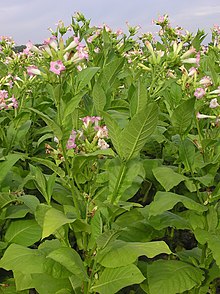Colnelensäure
| Strukturformel | |||||||||||||
|---|---|---|---|---|---|---|---|---|---|---|---|---|---|

| |||||||||||||
| Allgemeines | |||||||||||||
| Name | Colnelensäure | ||||||||||||
| Andere Namen |
| ||||||||||||
| Summenformel | C18H28O3 | ||||||||||||
| Externe Identifikatoren/Datenbanken | |||||||||||||
| |||||||||||||
| Eigenschaften | |||||||||||||
| Molare Masse | 292,42 g·mol−1[1] | ||||||||||||
| Sicherheitshinweise | |||||||||||||
| |||||||||||||
| Soweit möglich und gebräuchlich, werden SI-Einheiten verwendet. Wenn nicht anders vermerkt, gelten die angegebenen Daten bei Standardbedingungen. | |||||||||||||
Colnelensäure ist eine ungesättigte und konjugierte Divinylether-Fettsäure. Sie ist eng verwandt mit der Colnelsäure, die aber eine Doppelbindung weniger aufweist.
Vorkommen[Bearbeiten | Quelltext bearbeiten]

Colnelensäure kommt in Kartoffelpflanzen, Tabak und Tomatenpflanzen vor.[3][4][5]
Biologische Bedeutung[Bearbeiten | Quelltext bearbeiten]
Colnelensäure wird auf in Reaktion auf bestimmte äußere Einflüsse gebildet, z. B, bei Befall mit Bakterien oder Pilzen.[3][4][6] Sie inhibiert Phytophthora infestans, welche Kartoffeln befällt.[6]
Biosynthese[Bearbeiten | Quelltext bearbeiten]
Die Biosynthese geht von Linolensäure aus, die zunächst durch eine Lipoxygenase zum (S)-9-Hydroperoxid umgewandelt wird. Diese wird dann durch eine Divinylether-Synthetase zur Colnelensäure umgewandelt.[3][4][5][7][8]
Nachweis[Bearbeiten | Quelltext bearbeiten]
Es wurde eine chromatographische Methode publiziert, die speziell für die Analyse von Divinylether-Fettsäuren wie Colnelen- und Colnelsäure optimiert ist.[9]
Einzelnachweise[Bearbeiten | Quelltext bearbeiten]
- ↑ Shmuel Yannai: Dictionary of Food Compounds. CRC Press, 2004, ISBN 1-58488-416-9, S. 203.
- ↑ Dieser Stoff wurde in Bezug auf seine Gefährlichkeit entweder noch nicht eingestuft oder eine verlässliche und zitierfähige Quelle hierzu wurde noch nicht gefunden.
- ↑ a b c Alessandro Fammartino, Francesca Cardinale, Cornelia Göbel et al.: Characterization of a Divinyl Ether Biosynthetic Pathway Specifically Associated with Pathogenesis in Tobacco. In: Plant Physiology. Band 143, Nr. 1, 8. Januar 2007, S. 378–388, doi:10.1104/pp.106.087304.
- ↑ a b c Vladimir Y. Gorshkov, Yana Y. Toporkova, Ivan D Tsers et al.: Differential modulation of the lipoxygenase cascade during typical and latent Pectobacterium atrosepticum infections. In: Annals of Botany. Band 129, Nr. 3, 11. Februar 2022, S. 271–286, doi:10.1093/aob/mcab108.
- ↑ a b Payal Sanadhya, Anil Kumar, Patricia Bucki et al.: Tomato Divinyl Ether-Biosynthesis Pathway Is Implicated in Modulating of Root-Knot Nematode Meloidogyne javanica's Parasitic Ability. In: Frontiers in Plant Science. Band 12, 25. August 2021, doi:10.3389/fpls.2021.670772.
- ↑ a b Hans Weber, Aurore Chételat, Daniela Caldelari, Edward E. Farmer: Divinyl Ether Fatty Acid Synthesis in Late Blight–Diseased Potato Leaves. In: The Plant Cell. Band 11, Nr. 3, März 1999, S. 485–493, doi:10.1105/tpc.11.3.485.
- ↑ T. Galliard, D. R. Phillips, D. J. Frost: Novel divinyl ether fatty acids in extracts of Solanum tuberosum. In: Chemistry and Physics of Lipids. Band 11, Nr. 3, Oktober 1973, S. 173–180, doi:10.1016/0009-3084(73)90017-0.
- ↑ Payal Sanadhya, Anil Kumar, Patricia Bucki et al.: Tomato Divinyl Ether-Biosynthesis Pathway Is Implicated in Modulating of Root-Knot Nematode Meloidogyne javanica's Parasitic Ability. In: Frontiers in Plant Science. Band 12, 25. August 2021, doi:10.3389/fpls.2021.670772.
- ↑ Marcus Öhman, Hong Wang, Mats Hamberg, Lars G. Blomberg: Separation of divinyl ether fatty acid isomers by micellar electrokinetic chromatography. In: Electrophoresis. Band 22, Nr. 6, April 2001, S. 1163–1169, doi:10.1002/1522-2683()22:6<1163::AID-ELPS1163>3.0.CO;2-M.